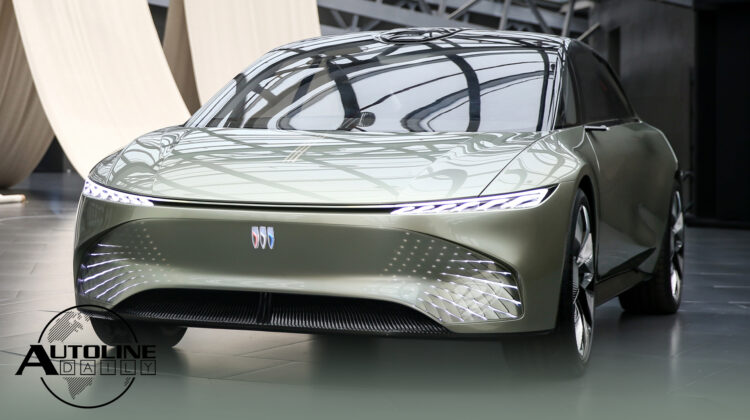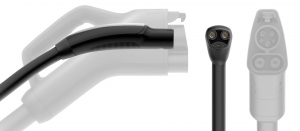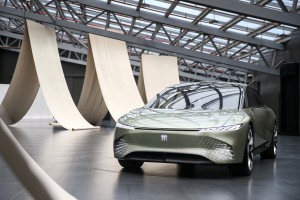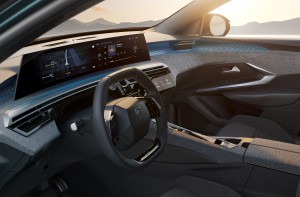
Listen to “AD #3582 – GM Developing New EV Architecture; Ford Quadruples BlueCruise Price; Tesla Plug Could Become Standard” on Spreaker.
Follow us on social media:
Runtime: 10:11
0:00 Ford Quadruples BlueCruise Price
0:51 Tesla NACS Could Become U.S. Charging Standard
1:46 Tesla Earns IRA Windfall
2:53 EV Lease Rates Are Soaring
3:27 GM Invests $1 Billion in HD Trucks
4:24 No Profit for $30K EVs
5:15 GM Developing New EV Architecture
6:24 Stellantis Refurbishes Cars with Old Parts
7:17 War Over AM Radio Rages On
8:11 Peugeot’s Wild New Interior Design
Visit our sponsors to thank them for their support of Autoline Daily: Bridgestone, Intrepid Control Systems, and Schaeffler.
This is Autoline Daily, the show dedicated to enthusiasts of the global automotive industry.
FORD QUADRUPLES BLUECRUISE PRICE
Ford significantly raised the price of its BlueCruise hands-free driving technology and customers aren’t happy about it. It costs $2,100 for a three-year subscription on the Mustang Mach-E but Ford is now charging an annual rate of $800 to renew it. Previously, it cost $200 annually. And there are plenty of comments on the mach-e forum website from owners upset with the price increase. Automakers are hoping to generate billions in subscription services in the future but as we’ve reported customers aren’t completely on board paying fees for extra features.
TESLA NACS COULD BECOME U.S. CHARGING STANDARD
Could Tesla’s charging system become the national standard in the U.S.? That’s what some people think. Ford’s deal to use Tesla’s chargers starting next year could force other charging companies like Charge Point, EVgo and Blink to start offering Tesla’s NACS or North American Charging Standard, as well as the current CCS, or Combined Charging System. But it goes both ways. In Europe, Tesla was forced by regulators to offer CCS plugs, and to qualify for IRA subsidies in the U.S., Tesla agreed to put CCS plugs at some of its stations. So far, U.S. subsidies for chargers are only for CCS, but if enough charging stations include NACS, maybe that will change.
TESLA EARNS IRA WINDFALL
Tesla is going to be one of the biggest benefactors of the Inflation Reduction Act. According to estimates from researcher Benchmark Mineral Intelligence, Tesla and its battery partner, Panasonic, will get $1.8 billion in tax credits this year for producing batteries in the U.S. Thanks to that, an analyst at Piper Sandler says the average price of a Tesla could fall by $125 every quarter for the next two years and not impact the company’s margins. GM and LG Energy are expected to get $480 million in battery production credits this year while Ford won’t receive any credits until 2025, which is when it will start battery production. The IRA hands out $90 per kWh in total for building battery packs, cells and modules in the U.S. That would be about $4,500 in credits for a vehicle with a 100-kWh battery.
EV LEASE RATES ARE SOARING
As expected, EV leasing is taking off in the U.S. That’s because leased EVs are classified as commercial sales and don’t have to meet domestic content requirements under the Inflation Reduction Act to qualify for the full $7,500 tax credit. Back in December before this loophole went into effect, the percentage of leased BEVs was 10% but according to JD Power that soared to 41% in April.
GM INVESTS $1 BILLION IN HD TRUCKS
Despite all our reporting on EVs, it’s no secret that legacy automakers will use profits generated from selling gas-burning vehicles to fund their electric futures. And GM is spending over a billion dollars to make improvements for the next-gen version of its full size pickups, some of the biggest money producers in its portfolio. It’s investing in its Flint assembly plant where it makes the Silverado and Sierra HD to expand and buy new tools and equipment. Last year, sales of those pickups were up almost 40% year over year.
NO PROFIT FOR $30,000 EVs
It doesn’t sound like GM is going to make much money on the all-new Equinox EV that’s coming out this fall. CEO Mary Barra said battery costs are still too high to make profitable mass-market vehicles that sell for $30,000 to $40,000. And GM has promised the base Equinox EV will have a starting price right around $30K, though that is not the first version of the electric Equinox that will hit the market this fall. Barra also said the same thing as Ford CEO Jim Farley, that EVs will not reach cost parity with ICE vehicles until 2030 or later. That’s when Farley expects Ford’s 3rd gen EVs to be hitting the market. And GM will probably be right along the same timetable.
GM DEVELOPING NEW EV ARCHITECTURE
We originally thought GM’s Ultium platform would underpin its EVs for many, many years to come. And I feel that’s the way it was presented to us. But Ultium must not have been good enough because GM is already working on a new EV architecture. And its design studio in China just revealed a new Buick sedan concept, called the Proxima, that’s made on this new architecture and will be used for internal research. Also take note of how the Proxima’s design language has changed from the Wildcat and Electa X that were shown not that long ago. The large gull-wing doors are a nice touch as well. Presumably, GM is making improvements to its new EV architecture and is probably why Mary Barra doesn’t see cost parity coming until 2030 or later. One last thing. What do you think this could be on the background monitor in this picture? It looks like it has a Chevy bowtie and it looks low and sporty. Could GM be designing the electric corvette?
STELLANTIS REFURBISHES CARS WITH OLD PARTS
Stellantis is getting into car flipping. It’s going to take end-of-life vehicles, recover parts that it can reuse or remanufacture and then recycle the rest. It will then take those old parts, along with new ones, fix up used vehicles at refurbishing centers, which in some cases will be old manufacturing sites and then it will resell those vehicles. Stellantis is like the Wheeler Dealers of automakers. And now it’s expanding those activities. Stellantis is forming a joint venture with a company, called Galloo, to do the first part of that process; get end-of-life vehicles to tear apart. They’ll start by the end of this year in France, Belgium and Luxembourg, before expanding across Europe. And they say they’re open to working with other automakers.
FIGHT OVER AM RADIO CONTINUES
As we’ve reported, there’s a growing battle over AM radio in the U.S. Lawmakers introduced a bill last month to prevent automakers from getting rid of AM radio in vehicles because they say it’s more reliable in an emergency than cellular networks. But the Alliance for Automotive Innovation, a lobbying group for the industry, will speak at a House panel later today to argue against the bill. Automakers say it isn’t necessary since emergency alerts are sent out over several platforms. Seven automakers have gotten rid of AM radio in their EVs because they say electromagnetic interference disrupts AM signals. Ford had planned on dropping AM too but decided not to after push back from lawmakers.
PEUGEOT’S WILD NEW INTERIOR DESIGN
Peugeot’s new interiors are going to be wild. It calls its interior design i-Cockpit and this is the newest generation that will debut in the all-new, all-electric 3008 crossover this September. Overall it’s a wedgy look with angular and somewhat blocky components, which seem embedded into surfaces, yet contrasting materials and well defined lines helps create separation. There’s also a large scalloped section out of the upper dash and doors that’s highlighted with a bright mesh pattern. Rounding out the highlights is a large, floating 21-inch display screen that combines the instrument cluster and infotainment together.
And that brings us to the end of today’s show. Thanks for tuning in.
Thanks to our partner for embedding Autoline Daily on its website: WardsAuto.com
Seamus and Sean McElroy cover the latest news in the automotive industry for Autoline Daily.











